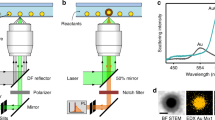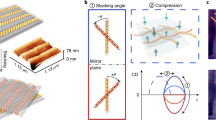Abstract
Tuning the optical1,2, electromagnetic3,4 and mechanical properties of a material requires simultaneous control over its composition and shape5. This is particularly challenging for complex structures at the nanoscale because surface-energy minimization generally causes small structures to be highly symmetric5. Here we combine low-temperature shadow deposition with nanoscale patterning to realize nanocolloids with anisotropic three-dimensional shapes, feature sizes down to 20 nm and a wide choice of materials. We demonstrate the versatility of the fabrication scheme by growing three-dimensional hybrid nanostructures that contain several functional materials with the lowest possible symmetry, and by fabricating hundreds of billions of plasmonic nanohelices, which we use as chiral metafluids with record circular dichroism and tunable chiroptical properties.
This is a preview of subscription content, access via your institution
Access options
Subscribe to this journal
Receive 12 print issues and online access
$259.00 per year
only $21.58 per issue
Buy this article
- Purchase on Springer Link
- Instant access to full article PDF
Prices may be subject to local taxes which are calculated during checkout





Similar content being viewed by others
References
Burda, C., Chen, X., Narayanan, R. & El-Sayed, M. A. Chemistry and properties of nanocrystals of different shapes. Chem. Rev. 105, 1025–1102 (2005).
Choi, C. L. & Alivisatos, A. P. From artificial atoms to nanocrystal molecules: Preparation and properties of more complex nanostructures. Annu. Rev. Phys. Chem. 61, 369–389 (2010).
Albrecht, M. et al. Magnetic multilayers on nanospheres. Nature Mater. 4, 203–206 (2005).
Hentschel, M., Schäferling, M., Weiss, T., Liu, N. & Giessen, H. Three-dimensional chiral plasmonic oligomers. Nano Lett. 12, 2542–2547 (2012).
Glotzer, S. C. & Solomon, M. J. Anisotropy of building blocks and their assembly into complex structures. Nature Mater. 6, 557–562 (2007).
Linic, S., Christopher, P. & Ingram, D. B. Plasmonic-metal nanostructures for efficient conversion of solar to chemical energy. Nature Mater. 10, 911–921 (2011).
Sun, S., Murray, C. B., Weller, D., Folks, L. & Moser, A. Monodisperse FePt nanoparticles and ferromagnetic FePt nanocrystal superlattices. Science 287, 1989–1992 (2000).
Xia, Y., Xiong, Y., Lim, B. & Skrabalak, S. E. Shape-controlled synthesis of metal nanocrystals: Simple chemistry meets complex physics? Angew. Chem. Int. Ed. 48, 60–103 (2009).
Mann, S. Self-assembly and transformation of hybrid nano-objects and nanostructures under equilibrium and non-equilibrium conditions. Nature Mater. 8, 781–792 (2009).
Grzybowski, B. A., Wilmer, C. E., Kim, J., Browne, K. P. & Bishop, K. J. M. Self-assembly: From crystals to cells. Soft Matter. 5, 1110–1128 (2009).
Seddon, A. M., Patel, H. M., Burkett, S. L. & Mann, S. Chiral templating of silica–lipid lamellar mesophase with helical tubular architecture. Angew. Chem. Int. Ed. 41, 2988–2991 (2002).
Sone, E. D., Zubarev, E. R. & Stupp, S. I. Semiconductor nanohelices templated by supramolecular ribbons. Angew. Chem. Int. Ed. 41, 1705–1709 (2002).
González, E., Arbiol, J. & Puntes, V. F. Carving at the nanoscale: Sequential galvanic exchange and kirkendall growth at room temperature. Science 334, 1377–1380 (2011).
Qin, L., Park, S., Huang, L. & Mirkin, C. A. On-wire lithography. Science 309, 113–115 (2005).
Pires, D. et al. Nanoscale three-dimensional patterning of molecular resists by scanning probes. Science 328, 732–735 (2010).
Glass, R., Möller, M. & Spatz, J. P. Block copolymer micelle nanolithography. Nanotechnology 14, 1153–1160 (2003).
Spatz, J. P. et al. Ordered deposition of inorganic clusters from micellar block copolymer films. Langmuir 16, 407–415 (1999).
Young, N. O. & Kowal, J. Optically active fluorite films. Nature 183, 104–105 (1959).
Robbie, K., Friedrich, L. J., Dew, S. K., Smy, T. & Brett, M. J. Fabrication of thin films with highly porous microstructures. J. Vac. Sci. Technol. A 13, 1032–1035 (1995).
Hawkeye, M. M. & Brett, M. J. Glancing angle deposition: Fabrication, properties, and applications of micro- and nanostructured thin films. J. Vac. Sci. Technol. A 25, 1317–1335 (2007).
Robbie, K., Brett, M. J. & Lakhtakia, A. Chiral sculptured thin films. Nature 384, 616–616 (1996).
Zhao, Y. P., Ye, D. X., Wang, G. C. & Lu, T. M. in Nanotubes and Nanowires 5219 (eds Lakhtakia, A. & Maksimenko, S.) 59–73 (2003).
Mokari, T., Sztrum, C. G., Salant, A., Rabani, E. & Banin, U. Formation of asymmetric one-sided metal-tipped semiconductor nanocrystal dots and rods. Nature Mater. 4, 855–863 (2005).
Algra, R. E. et al. Twinning superlattices in indium phosphide nanowires. Nature 456, 369–372 (2008).
Gansel, J. K. et al. Gold helix photonic metamaterial as broadband circular polarizer. Science 325, 1513–1515 (2009).
Kuzyk, A. et al. DNA-based self-assembly of chiral plasmonic nanostructures with tailored optical response. Nature 483, 311–314 (2012).
Fan, Z. & Govorov, A. O. Chiral nanocrystals: Plasmonic spectra and circular dichroism. Nano Lett. 12, 3283–3289 (2012).
Zhang, Z. Y. & Zhao, Y. P. Optical properties of helical and multiring Ag nanostructures: The effect of pitch height. J. Appl. Phys. 104, 013517–013517 (2008).
Moore, D. & Tinoco, J. I. The circular dichroism of large helices. A free particle on a helix. J. Chem. Phys. 72, 3396–3400 (1980).
Draine, B. T. & Flatau, P. J. Discrete-dipole approximation for scattering calculations. J. Opt. Soc. Am. A 11, 1491–1499 (1994).
Bruce, T. & Draine, P. J. F. User Guide for the Discrete Dipole Approximation Code DDSCAT 7.2. arXiv (2012).
Acknowledgements
We are grateful to C. Miksch and J. P. Spatz for providing us with micellar nanolithographically patterned substrates and for SEM access. We thank the Stuttgart Center for Electron Microscopy for technical support with the TEM imaging. This work was supported by the European Research Council under the ERC Grant agreement 278213.
Author information
Authors and Affiliations
Contributions
J.G.G. and A.G.M. built the shadow growth set-up, and grew the nanostructures. T-C.L. prepared the nanocolloidal solutions and carried out the TEM imaging. A.M. undertook numerical calculations. P.F. proposed the experiment, and A.G.M., J.G.G., T-C.L. and P.F. analysed the data and wrote the paper.
Corresponding author
Ethics declarations
Competing interests
The authors declare no competing financial interests.
Supplementary information
Supplementary Information
Supplementary Information (PDF 1512 kb)
Rights and permissions
About this article
Cite this article
Mark, A., Gibbs, J., Lee, TC. et al. Hybrid nanocolloids with programmed three-dimensional shape and material composition. Nature Mater 12, 802–807 (2013). https://doi.org/10.1038/nmat3685
Received:
Accepted:
Published:
Issue Date:
DOI: https://doi.org/10.1038/nmat3685
This article is cited by
-
Advances of medical nanorobots for future cancer treatments
Journal of Hematology & Oncology (2023)
-
Hierarchically manufactured chiral plasmonic nanostructures with gigantic chirality for polarized emission and information encryption
Nature Communications (2023)
-
Circularly Polarized Light-Enabled Chiral Nanomaterials: From Fabrication to Application
Nano-Micro Letters (2023)
-
Chiral metal nanostructures: synthesis, properties and applications
Rare Metals (2023)
-
Chiral nanomaterial-enabled bactericide and nanopesticide for sustainable agriculture and food safety
Journal of Nanoparticle Research (2023)



